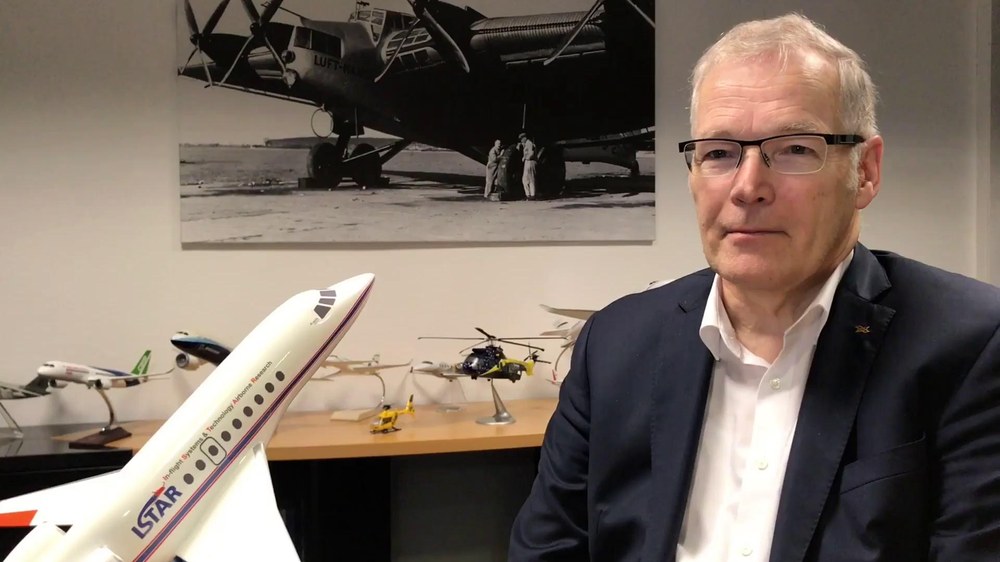ISTAR has its official rollout in Braunschweig


Your consent to the storage of data ('cookies') is required for the playback of this video on Quickchannel.com. You can view and change your current data storage settings at any time under privacy.

- Handover in the hangar of DLR’s Flight Experiments facility in Braunschweig together with representatives from science, industry, government and the media.
- Commissioning with first flight tests and further development of ISTAR begins.
- ISTAR joins the largest civil research aircraft fleet in Europe with a total of 11 aircraft and helicopters.
- Focal points: Aeronautics, digitalisation
On 20 February 2020, a new chapter in German aviation history began at the German Aerospace Center (Deutsches Zentrum für Luft- und Raumfahrt; DLR) facility in Braunschweig. The Falcon 2000LX research aircraft ISTAR (In-flight Systems and Technology Airborne Research) was presented to the public for the first time and handed over to DLR by the manufacturer, Dassault, at the official roll-out. This marked the starting point for the first flight tests and the further development of ISTAR. By the mid-2020s, the research aircraft will be fully operational as a flying simulator, while the digitalisation of air transport will be advanced through the creation of a digital twin.
"Our new ISTAR will allow us to work on new technologies, simulate new aircraft and further advance the digitalisation of air transport," says Rolf Henke, DLR Executive Board Member for Aeronautics Research. "After nine years of planning and development, today marks the start of a new era for aeronautics research at DLR."
"The new ISTAR airborne research platform is a realistic flight test system that is needed for the development of new, environmentally friendly, efficient aircraft, propulsion systems and assistance technologies. With ISTAR, we can advance the technologies necessary for climate-neutral flight in a systematic way,' says Thomas Jarzombek, the German Federal Government Coordinator of Aerospace Policy.

Video: DLR research aircraft ISTAR – a new star in the sky of aeronautical research
Your consent to the storage of data ('cookies') is required for the playback of this video on Youtube.com. You can view and change your current data storage settings at any time under privacy.
The handover, which took place in the hangar at the DLR Flight Experiments facility, was attended by numerous representatives of scientific research, industry, government and the media. The speakers and discussion partners looked to the future of ISTAR and back at DLR’s history of aeronautics research. For example, the flying simulator VFW-614 Advanced Technologies Testing Aircraft System (ATTAS) was stationed at the Braunschweig site until 2012.
Following preliminary work at the Dassault plant in Bordeaux, ISTAR will now be fitted with a basic measurement system for collecting and delivering a range of flight test data. In addition, the aircraft will be equipped with workstations for flight test engineers, who will control experiments and monitor flight parameters. The HighFly (High speed inflight validation) project is the first step in the construction of this research facility and marks the start of initial research work and research flights in the fields of aerodynamics, aeroelasticity, structures and propulsion systems. Two further conversion phases at Dassault are planned for 2023 and the mid-2020s, bringing ISTAR to full operational capability.
Once fully developed, ISTAR will be able to test the flight characteristics of new aircraft designs, whether real or virtual, crewed or uncrewed, under real operating conditions. The digital twin of ISTAR, which is also planned, will be a digital description of the aircraft. This will be used to track and plan modifications, maintenance, repairs and operational activities. The new research aircraft is based at DLR's Flight Experiments facility in Braunschweig and is now part of the largest civilian research fleet in Europe, with a total of 11 aircraft and helicopters.
The ISTAR purchase agreement was signed at the ILA Berlin Air Show in April 2018, in the presence of German Federal Chancellor Angela Merkel. The first phase of modification work at Dassault followed immediately thereafter. In future, the aircraft will be used for DLR research work and will also be made available to other German and European research institutions, aircraft manufacturers and suppliers.
